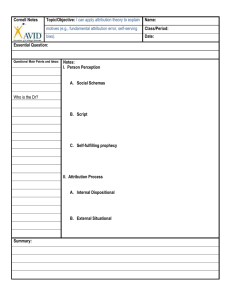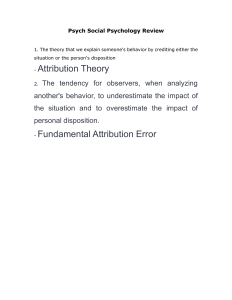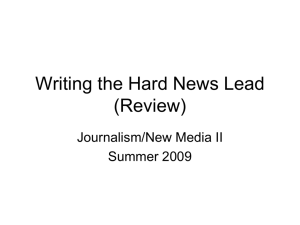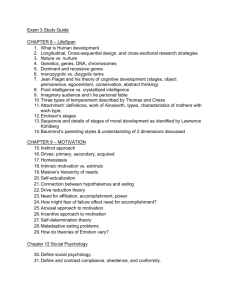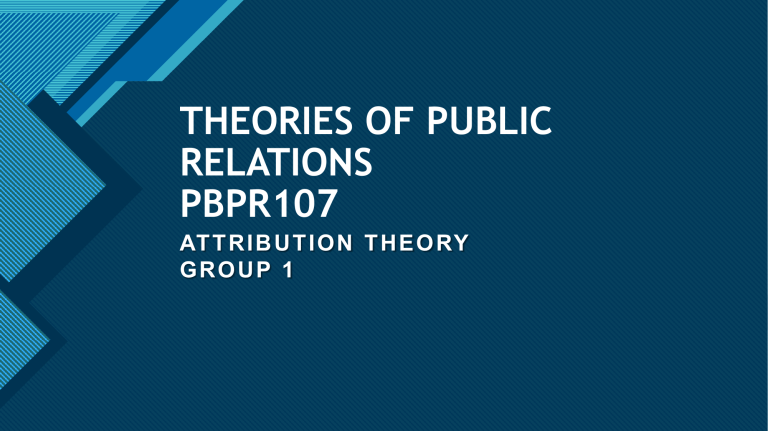
Click to edit Master title style THEORIES OF PUBLIC RELATIONS PBPR107 AT T R I B U T I O N T H E O RY GROUP 1 1 Click to edit Master title style TOPICS Brief history and definition of attribution Assumptions of attribution theory Internal attributions External (Situational) attributions The fundamental attribution error The Covariation Model Kelley's Cube Discounting principle Correspondent Inference Theory (CIT) Weiner’s model Achievement Attribution Difference between Kelley's and Weiner's Theory Benefits of attribution theory Criticisms of attribution theory References 2 2 BRIEF AND DEFINITION OF ATTRIBUTION Click toHISTORY edit Master title style THEORY The Attribution Theory was first introduced by Fritz Heider in 1958 and is based on the assumption that people naturally try to understand the reasons behind other people's behavior. It involves determining whether behavior is linked to the External or Internal factors. Additionally, people tend to attribute outcomes or achievements to specific traits or conditions. The Attribution Theory is applicable in educational settings and can impact learning motivation, as causal attributions determine affective reactions to success and failure 3 3 BRIEF AND DEFINITION OF ATTRIBUTION Click toHISTORY edit Master title style THEORY part 2 Attribution theory is a psychological concept that helps to explain how people make judgments about the causes of behaviour. Simply put it explains how people assess the causes of behaviour. A formal definition is provided by Fiske and Taylor (1991, p. 23) “Attribution theory deals with how the social perceiver uses the information to arrive at causal explanations for events. It examines what information is gathered and how it is combined to form a causal judgment”. 4 4 TYPES ATTRIBUTION THEORIES Click toOF edit Master title style According to Heider, "people measure others” behaviours by either their internal disposition or the external situation that they're in" (Thompson, 2021). Internal (Dispositional) attributions refer to factors that are believed to be under the control of the individual, such as personality traits, abilities, and efforts. Internal attributions focus on the personal characteristics of an individual and assume that their behaviour is driven by their personality, abilities, or effort. 5 5 Internal Click to attributions edit Master title style Three categories of information shape internal attributions: 1. Choice: The degree of choice the individual had in their behaviour. When people have a choice in their actions, their behaviour is more likely to be seen as reflecting their characteristics. 2. Expected behaviour: The degree to which the individual's behaviour is consistent with their personality or social role. If someone's behaviour is consistent with what is expected of them based on their personality or social role, their behaviour is more likely to be attributed to their characteristics. 3. Effects of behaviour: If the consequences of the behaviour are seen as positive, the behaviour is more likely to be attributed to the individual's personal characteristics. 6 6 External (Situational) attributions Click to edit Master title style External attributions, refers to factors that are believed to be outside of the individual's control, such as luck, chance, or situational factors. For example, if a student receives a failing grade on an exam, an external attribution would be that the exam was too difficult, the teacher did not provide enough resources or feedback, or the student was experiencing stress or distraction. 7 7 The Attribution Error ClickFundamental to edit Master title style The fundamental attribution error is a cognitive bias that occurs when people tend to overemphasize dispositional (internal) explanations for others' behaviour and underestimate situational (external) factors. In other words, people tend to attribute the behaviour of others to their personality traits, beliefs, or motivations, rather than taking into account the situational context in which the behaviour occurs. 8 8 ASSUMPTIONS OF ATTRIBUTION THEORY Click to edit Master title style A. The first assumption is that people tend to assign causes to behaviour. This means that when people observe someone's behaviour, they automatically try to figure out why they acted that way. B. The second assumption is that people assign causes to behaviour not randomly but through systematic processes. This means that people use a set of rules or heuristics (heuristics are mental shortcuts or rules of thumb that people use to make judgments or decisions quickly and efficiently, without having to invest significant time or effort into processing information. 9 9 ASSUMPTIONS OF ATTRIBUTION THEORY Click to edit Master title style C. The third assumption holds that when attributions are made, they influence feelings and subsequent behaviour and are resistant to change. This indicates that people's emotional responses and behaviour toward a person or event can be influenced by the attributions they make. 10 10 Click to edit MODELS OF ATTRIBUTION Master title style THEORY Harold Kelley was a social psychologist who developed several attribution models that help explain how people make judgments about the causes of behaviour. Harold Kelley proposed several models in attribution theory. Here are some of his most wellknown models: Covariation Model Kelley's Cube Discounting Effect/Principles Correspondent Inference Theory 11 11 ClickCovariation The to edit Master Model title style • Kelley’s (1967) Covariation model is the best-known attribution theory. • The term Covariation simply means that a person has information from multiple observations at different times and situations. • The theory states that to form an attribution about what caused a person’s behaviour, we systematically note the pattern between the presence or absence of possible causal factors and whether or not the behaviour occurs. • He argues that people act like scientists in trying to discover the causes of behaviour. 12 12 ClickCovariation The to edit Master Model titlePart style 2 More specifically, they take into account three kinds of evidence: A. Consensus: the extent to which other people behave in the same way in a similar situation. High consensus occurs when many people behave similarly, while low consensus occurs when only a few people behave in a particular way. B. Distinctiveness: the extent to which the person behaves in the same way in similar situations. If a behaviour is specific to one situation, then distinctiveness is low, but if the behaviour is generalizable to other situations, then distinctiveness is high. C. Consistency: the extent to which the person behaves like this every time the situation occurs. If a behaviour is consistent over time, then consistency is high, but if the behaviour varies over time, then consistency is low. 13 13 ClickCovariation The to edit Master Model titlePart style 3 14 14 ClickCovariation The to edit Master Model titlePart style 4 According to Kelley's theory, when consensus and distinctiveness are low but consistency is strong, we are more likely to attribute others' behaviour to internal factors. In contrast, when consensus, consistency, and distinctiveness are all high, we are more prone to assume that the other person's behaviour results from outside forces. 15 15 Click to edit Kelley's CubeMaster title style Kelley's Cube is an extension of his Covariation Model that provides a framework for understanding how people make attributions. The cube represents the three dimensions of consensus, distinctiveness, and consistency. Kelley's cube attribution model and Kelley's Covariation model are used interchangeably in the literature. The model is used to understand how people make attributions about others' behaviours based on their observations of the situation in which the behaviour occurs. 16 16 Click to edit Kelley's CubeMaster title style The Covariation model is one specific version of Kelley's cube model, which focuses on the role of Covariation, or correlation, between events and potential causes, in determining causal attributions. Overall, both models seek to explain how people make causal attributions about others' behaviour based on their observations of the situation, and are commonly used in the fields of psychology, sociology, and communication. 17 17 Click to editEffect Master title style Discounting Principle • Harold Kelley's discounting principle states that when people have multiple potential causes for an event, they tend to discount the importance of any one cause. Essentially, when people know there are multiple possible reasons for an action or outcome, they are less likely to attribute it to any one specific cause. • The discounting effect has important implications in public relations and communication, as it underscores the importance of clear messaging and consistent branding. If a company or organization is known for a specific product or service, but then begins to offer many different products or services, customers may begin to discount the importance of the original product or service. 18 18 Click to edit Effect Discounting MasterPrinciple title style • Overall, the discounting effect highlights the importance of carefully considering all potential causes for an event or outcome, and of communicating information clearly and consistently to avoid confusion and ambiguity. 19 19 Click to edit Master Correspondent Inference title style Theory Kelley's Correspondent Inference Theory (CIT) is a model in attribution theory that explains how people make judgments about others' behaviour. The CIT suggests that people infer a dispositional attribute (e.g. personality traits) of another person when the person's behaviour is freely chosen, uniquely performed, and produces non-common effects. According to the CIT, people make correspondent inferences when they perceive a strong correspondence between a person's behaviour and the person's underlying disposition 20 20 Click to edit Master Correspondent Inference title style Theory However, correspondent inferences are not always accurate. In some cases, the behaviour may not correspond with the person's underlying disposition. To address this issue, Kelley proposed that people use additional information to adjust their correspondent inferences. For example, people may consider situational constraints that could explain the behaviour. Overall, the Correspondent Inference Theory has important implications for communication and public relations. By understanding how people make inferences about others' behaviour, public relations practitioners can better manage their image and reputation 21 21 Click to edit Master title Weiner’s style model Bernard Weiner suggested that four key factors have a direct impact on attributions: effort, luck, task difficulty, and ability. He went on to state that these factors can be divided into three distinct dimensions: A. Locus of control B. Stability C. Controllability 22 22 Click to edit Master title Weiner’s style model A. Locus of control This refers to whether the cause is attributed to the person (internal locus) or the situation (external locus). B. Stability This refers to whether the cause is considered to be stable or unstable over time. C. Controllability This refers to whether the cause is something that the individual can control or not. 23 23 Click to edit Master title Weiner’s style model Achievement of Attribution According to Weiner, individuals attribute their achievements to four factors: effort, ability, task difficulty, and chance. 1. Effort attribution refers to the belief that an individual's success is due to the effort they put into a task. For example, a student who receives an A on a test may attribute their success to the hours of studying they put in. 2. Ability attribution refers to the belief that an individual's success is due to their innate abilities or talents. For example, professional athlete may attribute their success to their natural physical abilities and athletic talent. 24 24 Click to edit Master title Weiner’s style model Achievement of Attribution part 2 3. Task difficulty attribution refers to the belief that an individual's success is due to the level of difficulty of the task they accomplished. For example, a chef who creates an elaborate and complex dish may attribute their success to the level of difficulty of the recipe. 4. Chance attribution refers to the belief that an individual's success is due to luck or external factors beyond their control. For example, a lottery winner may attribute their success to being in the right place at the right time or simply being lucky. 25 25 Click to editbetween Master title styleand Weiner's Theory Difference Kelley's The following are the primary distinctions between Weiner's and Kelley's frameworks. First, as Martinko and Thomson (1998) point out, while Weiner's studies are more focused on how people examine the causes of their conduct, the majority of Kelley's investigations focus on how people attribute causes to the behaviour of other people. Secondly, and more crucially, while Weiner's model emphasizes the outcomes of such causal attribution, Kelley's model is more concerned with the process of attribution (the psychological process explaining causal attribution). According to Kelley, attribution theories are those that concentrate on the act of attributing causes. 26 26 Click to editbetween Master title styleand Weiner's Theory part 2 Difference Kelley's Kelley's Theory Weiner's Theory It focuses on how people examine the causes of other people's behaviour. It focuses on how people examine the causes of their behaviour. More focused on the process of attribution More focused on the outcomes of causal attribution. 27 27 Click to editOF Master title styleTHEORY CRITICISMS ATTRIBUTION 1. It relies on normative models, which assume that people process information logically and rationally 2. Attribution theory may oversimplify the complex process of making attributions. 3. The fundamental attribution error (explained earlier) 4. Experiments often rely on artificial manipulations of variables and may not reflect the complexity and messiness of real-life situation 28 28 Click to edit Master title style REFERENCES Weiner, B. (1985). An attributional theory of achievement motivation and emotion. Psychological Review, 92(4), 548-573. Weiner, B. (2010). The development of an attribution-based theory of motivation: A history of ideas. Educational Psychologist, 45(1), 28-36. Weiner, B. (1985). An attributional theory of achievement motivation and emotion. Psychological Review, 92(4), 548-573. Gernigon, C., Sauzeon, H., Riviére, J., Rodrigues, J., & Brouillet, D. (2016). A systematic review of attributional style in depression and anxiety: Do stable attributions for internal, stable and global causes of negative events confer vulnerability? Journal of Affective Disorders, 202, 192-203. Kelley, H. H. (1967). Attribution theory in social psychology. In D. Levine (Ed.), Nebraska Symposium on Motivation, 15, 192-238. Kelley, H. H. (1973). The process of causal attribution. American Psychologist, 28(2), 107-128. Kelley, H. H. (1967). Attribution theory in social psychology. In Nebraska symposium on motivation (Vol. 15, pp. 192-238). Weiner, B. (1986). An attributional theory of motivation and emotion. Springer Science & Business Media. Kelley, H. H. (1967). Attribution theory in social psychology. In Nebraska symposium on motivation (Vol. 15, pp. 192-238). Cherry, K. (2021). Kelley's Covariation Model in Psychology. Verywell Mind. https://www.verywellmind.com/kelleys-covariation-model-2795905 Kelley, H. H. (1973). The processes of causal attribution. American Psychologist, 28(2), 107-128. Jones, E. E., & Davis, K. E. (1965). From acts to dispositions: The attribution process in person perception. Advances in Experimental Social Psychology, 2, 219-266. Malle, B. F. (2004). How the mind explains behaviour: Folk explanations, meaning, and social interaction. MIT press. 29 29 Click to edit Master title style REFERENCES • Jones, E. E., & Davis, K. E. (1965). From acts to dispositions: The attribution process in person perception. In L. Berkowitz (Ed.), Advances in experimental social psychology (Vol. 2, pp. 219-266). Academic Press. • Martinko, M. J., & Thomson, N. F. (1998). Attribution theory: An organizational perspective. In C. L. Cooper & I. T. Robertson (Eds.), International review of industrial and organizational psychology (Vol. 13, pp. 121-155). Wiley. • Ross, L. (1977). The intuitive psychologist and his shortcomings: Distortions in the attribution process. In L. Berkowitz (Ed.), Advances in experimental social psychology (Vol. 10, pp. 173-220). Academic Press. • Heider, F. (1958). The psychology of interpersonal relations. John Wiley & Sons. • Kelley, H. H. (1967). Attribution theory in social psychology. In D. Levine (Ed.), Nebraska Symposium on Motivation (pp. 192-238). University of Nebraska Press. • Weiner, B. (1985). An attributional theory of achievement motivation and emotion. Psychological Review, 92(4), 548-573. • Benoit, W. L. (2013). Accounts, excuses, and apologies: A theory of image restoration strategies. SUNY Press. • Coombs, W. T. (2014). Ongoing crisis communication: Planning, managing, and responding. Sage Publications. • Cheney, G., Christensen, L. T., Zorn, T. E., & Ganesh, S. (2010). Organizational communication in an age of globalization: Issues, reflections, practices. Waveland Press. • Gyamfi, M. (2020). Communicating about COVID-19 in Ghana: Insights from attribution theory. Journal of African Media Studies, 12(4), 517-531. • Asamoah, E. (2019). Corporate social responsibility and corporate reputation in Ghana. Corporate Communications: An International Journal, 24(4), 564-579. • Nkrumah, K. (2017). Building trust through effective public relations practice: The case of Ghana's public sector. International Journal of Business and Social Science, 8(1), 3030 116-123. Click to edit Master title style Thank You 31
